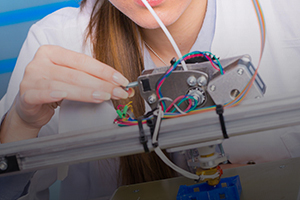Plastic-Metal 3D Printer

A new printer has been developed that enables the production of plastic-metal hybrid parts on a single printer. The advancement could pave the way for more reliable and complex parts for 3-dimensional electronics, robotics and other applications.
In traditional fused filament fabrication (the most widely used 3-D printing process), parts can be printed using either plastic or metal. However, because of the different melting points, it’s impossible to make parts using both metal and plastic simultaneously. Instead, plastic parts are soaked in a solution containing palladium (Pd). Once coated with Pd, the object is submerged in an electroless plating bath where dissolved metal ions are deposited onto the surface. A major drawback of this process is that the coating is non-uniform and adhesion is poor.
The new printer employs a dual nozzle that can extrude either standard melted ABS or ABS that already contains palladium chloride (PdCl2) selectively within a printed object. In this way, specific areas can be selected for plating. The researchers have found that the new technique eliminates the need for etching of the plastic prior to plating, and when Pd is loaded directly into the raw material, adhesion is also much higher.
For information: Shinjiro Umezu, Waseda University, 1-104 Totsukamachi, Shinjuku-ku, Tokyo, 169-8050, Japan; Website: https://www.waseda.jp/top/en/ or https://www.waseda.jp/top/en/news/73810